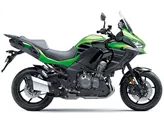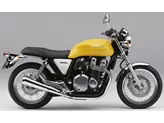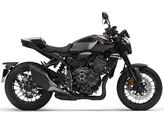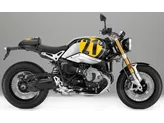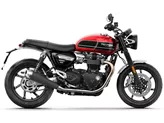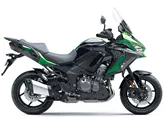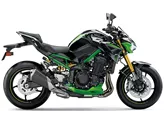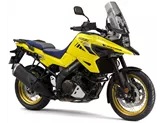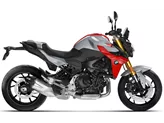Kawasaki Versys 1000 2016 vs. Kawasaki Z900 RS 2018

Kawasaki Versys 1000 2016

Kawasaki Z900 RS 2018
Vue d’ensemble - Kawasaki Versys 1000 2016 vs Kawasaki Z900 RS 2018
The Kawasaki Versys 1000 model year 2016 and the Kawasaki Z900 RS model year 2018 are both impressive motorcycles with their own unique features and strengths.
Starting with the Kawasaki Versys 1000 2016, it boasts a sporty look and a comfortable seating position, making it suitable for long rides. Its in-line four-cylinder engine delivers a powerful and refined performance, with an engine power of 120 HP and torque of 102 Nm. The adjustable windshield allows for customization based on the rider's preference. The chassis of the Versys 1000 is stable and provides a well-controlled braking system. Additionally, it offers a clever range of accessories and comes at a comparatively low price, making it an attractive option for riders.

Kawasaki Versys 1000 2016
On the other hand, the Kawasaki Z900 RS 2018 is known for its powerful and smooth engine, with an engine power of 111 HP and torque of 98.6 Nm. It also has a stylish design that appeals to many riders. The seating position is comfortable, and the bike is easy to ride with balanced handling. Unlike some other retro bikes in its class, the Z900 RS is not nervous or ponderous, providing a more enjoyable riding experience.

Kawasaki Z900 RS 2018
While the Versys 1000 has a few weaknesses, such as the windshield only being adjustable when stationary and the gear indicator costing extra, the Z900 RS also has its own drawbacks. It does not have a shift assistant, which can be a disadvantage for riders who prefer quick and seamless gear shifts. Additionally, the Z900 RS is slightly heavier than other retro bikes in its class, and the seat may feel a little too soft on long tours. Furthermore, it lacks wind protection, which can be a drawback for riders who frequently ride on highways or in windy conditions.
In conclusion, both the Kawasaki Versys 1000 2016 and the Kawasaki Z900 RS 2018 have their own strengths and weaknesses. The Versys 1000 offers a sporty look, comfortable seating position, and a powerful engine, while the Z900 RS boasts a smooth engine, good looks, and balanced handling. Ultimately, the choice between the two will depend on the rider's preferences and priorities.
Caractéristiques techniques Kawasaki Versys 1000 2016 par rapport à Kawasaki Z900 RS 2018
Avantages et inconvénients en comparaison
Avantages et inconvénients en comparaison
Kawasaki Versys 1000 2016

La Kawasaki Versys 1000 n'est pas un modèle entièrement nouveau - même si son design en donne l'impression. Son look a été très habilement adapté à la ligne agressive actuelle de Kawasaki, avec deux phares pointus et de nombreuses arêtes à l'avant. Sur le plan technique en revanche, elle a été améliorée avec précaution - mais de manière tout à fait judicieuse. Deux chevaux supplémentaires font passer la puissance à 120 ch, qui se laissent parfaitement conduire grâce à la magnifique caractéristique du quatre cylindres en ligne. Le châssis correspond aux exigences sportives d'une Kawasaki, l'ergonomie et la position de conduite confortable permettent néanmoins de voyager loin - comme le prévoit le cahier des charges d'une grande enduro. Avec des accessoires judicieux comme un set de valises, un top-case, des poignées chauffantes et des phares supplémentaires, la Versys 1000 se transforme en une touriste sérieuse sur de longues distances - le prix de base relativement bas rend ces gadgets tout à fait abordables.
Kawasaki Z900 RS 2018

Son quatre cylindres est doux comme de la soie et fournit en même temps suffisamment de puissance pour faire sourire sous le casque. De plus, elle est très facile à déplacer, ce qui devrait en faire un excellent véhicule de banlieue au quotidien et un funbike culte le week-end. L'optique trouve le juste milieu entre le design classique et les détails modernes pour former un ensemble rétro cohérent, qui est en même temps un hommage digne de l'histoire de Kawasaki. C'est une superbe nakedbike à l'allure élégante.
Comparaison des prix Prix moyen du marché Kawasaki Versys 1000 vs Kawasaki Z900 RS
There are a few key differences between a Kawasaki Versys 1000 2016 and a Kawasaki Z900 RS 2018. In terms of price, the actual average price of a Kawasaki Z900 RS 2018 is about 24% higher. A Kawasaki Versys 1000 2016 experiences a loss of 1,080 USD in one year and 930 USD in two years of ownership. This is offset by a loss of 900 USD and 1,070 USD for a Kawasaki Z900 RS 2018. Compared to Kawasaki Z900 RS 2018 there are less Kawasaki Versys 1000 2016 bikes available on the 1000PS.de Marketplace, specifically 7 compared to 28. It takes less time to sell a Kawasaki Versys 1000 with 88 days compared to 154 days for a Kawasaki Z900 RS. Since model year 2012 1000PS.de editors have written 19 reviews for the Kawasaki Versys 1000 and 26 reviews for the Kawasaki Z900 RS since model year 2018. The first review for the Kawasaki Versys 1000 was published on 11/7/2011 and now has more than 8,400 views. This compares to more than 63,700 views for the first review on Kawasaki Z900 RS published on 9/6/2017.



